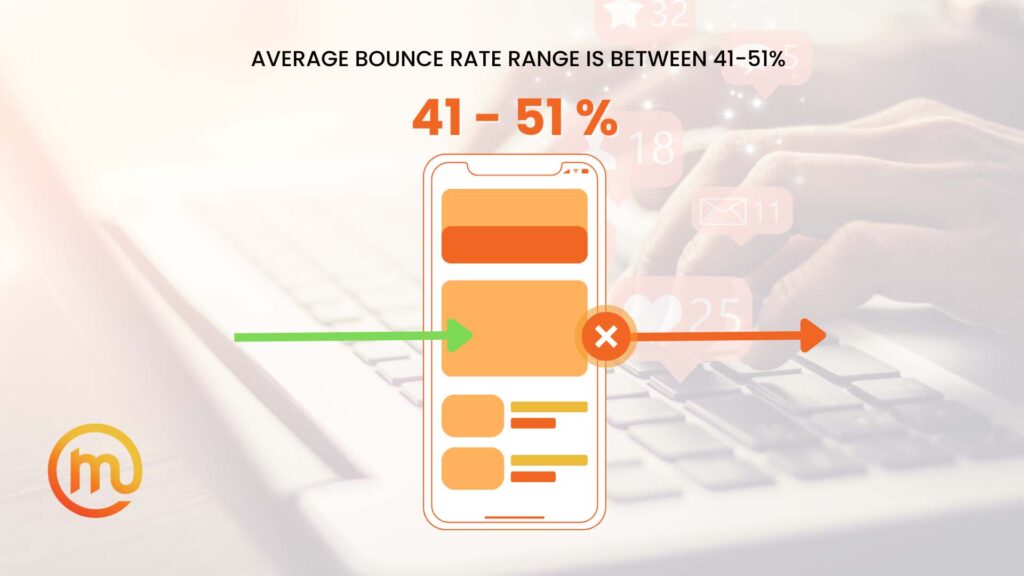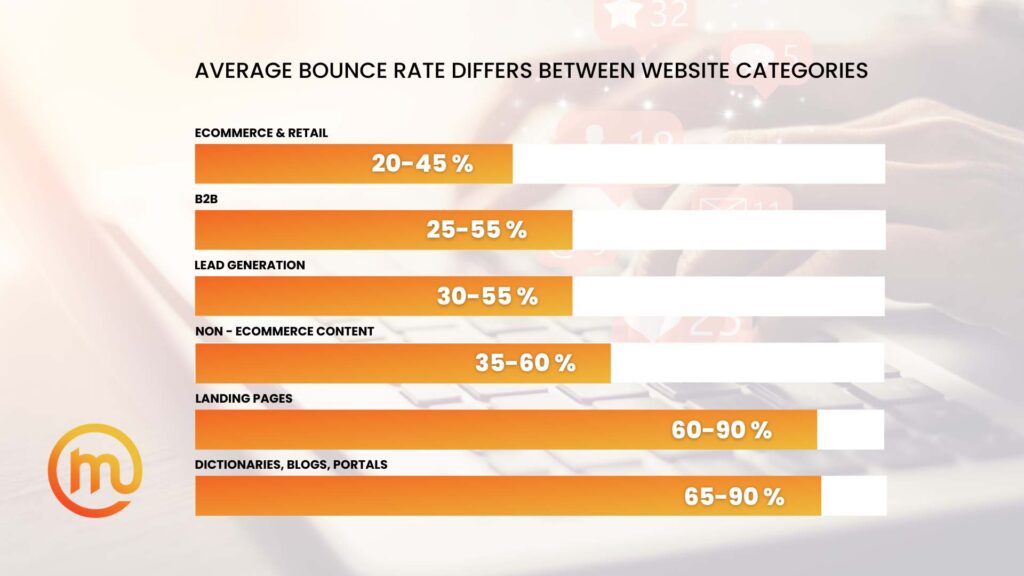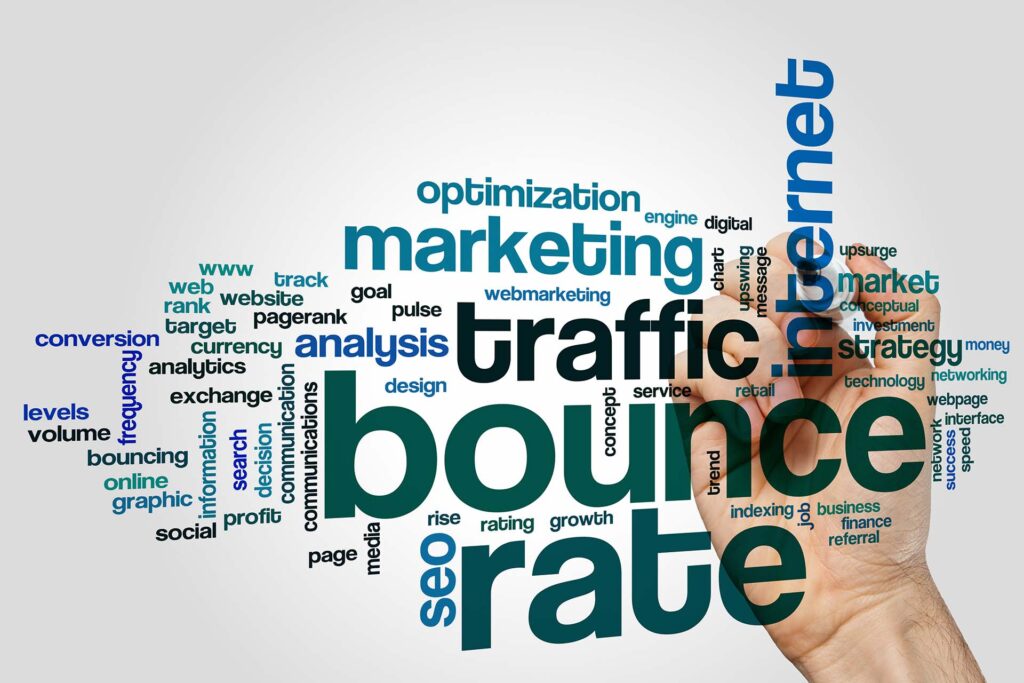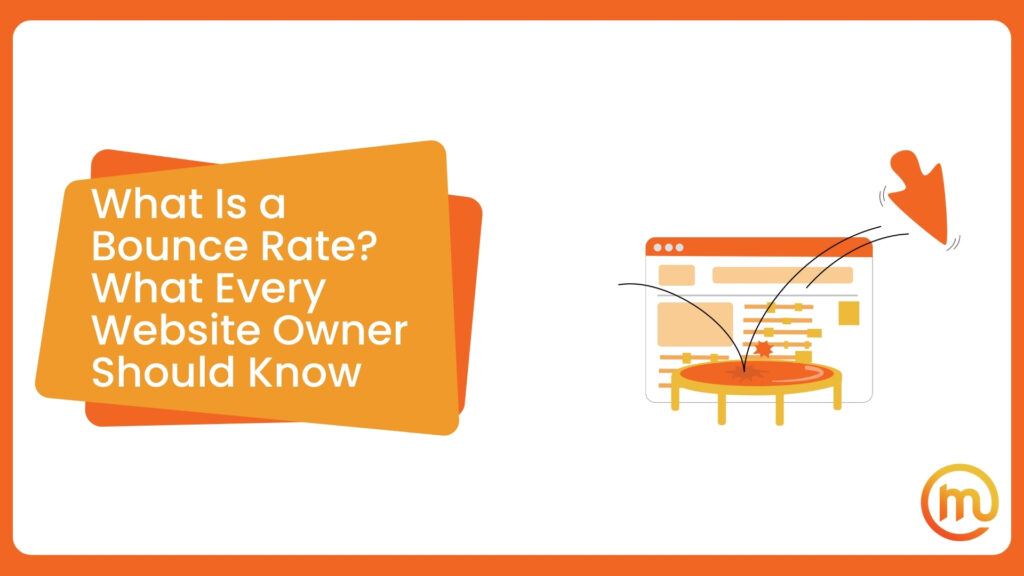In the digital realm, traffic isn’t just about quantity – it’s also about quality. And one of the most important metrics to keep an eye on when you’re trying to rank is the bounce rate. But what is a bounce rate, and how can it help you become and stay relevant?
A bounce rate is a percentage that represents the number of people who visit a single page on a website and then leave without clicking on anything else or navigating to any other pages. Think of it as a measure of how many visitors “bounce” off your site after viewing only one page. If your website has a high number of visitors leaving, it may mean that they are not finding what they’re looking for or the page isn’t user-friendly. Lower rates, on the other hand, can indicate that your site is engaging and encourages visitors to explore more.
What Is a Bounce Rate? The Bounce Rate Meaning Explained
As a professional SEO agency, we offer a comprehensive range of SEO marketing services to help your website achieve higher rankings, greater visibility, and more organic traffic. We understand that while driving traffic to your website is important, it’s equally critical to keep your visitors engaged. That’s where the data known as the bounce rate comes into play.
Let’s start with – what does bounce rate mean? This term is often used in digital marketing and web analytics, but what exactly does this data mean? Essentially, a “bounce” refers to a single-page session on your website. It occurs when a visitor lands on a page (through a search engine or social media) and leaves without interacting with any other elements or navigating to other pages on your site.
Bounces can be triggered by actions such as clicking on an external link, pressing the “back” button on the browser, closing the browser or browser tab, entering a new URL, or even session timeouts due to inactivity.
How Calculating and Interpreting Bounce Rate Works
Now that you know the bounce rate definition, let’s explain how this data is calculated. It’s calculated as a percentage by dividing the number of bounces by the total number of sessions and then multiplying by 100. It provides valuable insights into user behavior, and this data can indicate whether users are finding the content on your pages relevant and engaging. For example, if your website receives 1,000 sessions and 500 of those are bounces, your bounce rate would be 50%. This means that half of your visitors left after viewing only one page, signaling an opportunity for further analysis and possible improvements to your site’s content and user experience.
Use Google Analytics to Better Understand and Reduce Bounces
Google Analytics is a tool that helps website owners understand how visitors interact with their sites. It tracks various details like how many people visit your site, how long they stay, and which pages they view. One of the key metrics shows the percentage of visitors who leave your site after viewing only one page.
Google Analytics is very handy when it comes to showing you which exact pages have high bounce rates, and from there – you can start figuring out why. Maybe the page loads slowly, the content isn’t what users expected, or it’s hard to navigate. If you’re unfamiliar with these metrics, our website development agency can help you narrow down the problems and make changes to improve your site and encourage visitors to stay longer.

Tips to Learn to Recognize Causes For High Rates
A high number of users leaving can be a signal of various underlying issues with your website that are causing visitors to leave without further interaction. Some of the potential reasons include the following:
- When users find that the content doesn’t meet their expectations or fails to provide value, they’re likely to leave. Ensure that your content is relevant, informative, and engaging to your target audience.
- Titles and meta descriptions that don’t accurately represent the content can lead to disappointment for users and prompt them to leave. SEO works efficiently, so ensure that your titles and descriptions are clear and concise and provide an accurate preview of the content.
- A confusing layout, difficult navigation, or a lack of mobile responsiveness can frustrate users and drive them away. That is why you need to make sure your website design is user-friendly, intuitive, and responsive across all devices.
- Slow-loading pages can make users impatient, especially on mobile devices where quick access is expected. To avoid this, you should optimize your site’s performance by compressing images, minimizing code, and using a content delivery network (CDN) to speed up load times.
- Too many ads or aggressive pop-ups can disrupt the user experience and be off-putting. That’s why it’s necessary to strike a balance between monetization and user experience by limiting the number of ads and ensuring that pop-ups are not overly intrusive.
- When visitors aren’t guided on what to do next, they might simply leave. To overcome this issue, you should incorporate clear and compelling CTAs that direct users to take a desired action, such as signing up for a newsletter or exploring related content.
- When your content or products don’t align with the interests or needs of your users, engagement can suffer. It’s paramount to conduct audience research to understand their preferences and needs and tailor your content accordingly.
If you manage to address all these factors and keep them in check, you can make significant improvements to your website. However, managing all these aspects can be time-consuming and require specialized knowledge. That’s where a professional content marketing agency, one that also does content and works as a website design agency, can be invaluable.
What Is a Good Bounce Rate?
So, what’s a good bounce rate? It typically falls within the 26% to 40% range. However, it’s important to consider the context of your website and industry when assessing these metrics. It’s important to note that a higher bounce rate isn’t always a bad thing. For example, if the purpose of a page is to provide quick information, a high number of visitors leaving may be expected.
However, if your goal is to encourage further engagement and exploration of your site, a lower rate is ideal. To improve your rates, ensure that your website has clear calls to action, relevant content, and a user-friendly design.

Reduce Bounce Rate With These Strategies
Reducing the number of bounces is a continuous process, so it’s important to keep analyzing and refining your approach to achieve the best results on the web. There are some key strategies you should consider that can help keep users engaged and stay on your website.
Improve Page Load Times
Slow page load times can frustrate visitors and lead them to exit your site quickly. You can speed up your pages by compressing images, minimizing code, reducing server response times, and utilizing browser caching. Tools like Google PageSpeed Insights can identify specific areas that need improvement.
Create Engaging Content on Your Website
Quality content is key to retaining users. Craft content that addresses your target audience’s needs and interests. Craft compelling headlines, clear formatting, and include helpful visuals to make your content more engaging, easily digestible, and understandable.
Follow Tips to Optimize for Mobile
As more users access websites via smartphones and tablets, it’s crucial that your site provides a seamless mobile experience. Make sure your site is responsive so it adapts to different screen sizes, and test its mobile performance to ensure smooth navigation and fast load times.
Improve Navigation and Layout
A clear, intuitive site structure helps users find what they’re looking for quickly. Ensure that your layout is clean and user-friendly, with well-defined sections and easy-to-read fonts. Use a well-organized menu, categories, and a search feature to make the navigation simple and easy.
Avoid Intrusive Ads and Pop-ups
Excessive ads and pop-ups can be off-putting to users. While they can serve a purpose, use them sparingly and ensure they don’t disrupt the user experience. Make sure your pop-ups are relevant, timed appropriately, and easy to close.
Use Clear Calls-to-Action (CTAs)
CTAs guide users toward specific actions, such as subscribing to a newsletter or making a purchase. Incorporate compelling language and design elements to make your CTAs stand out. Ensure they’re strategically placed and provide clear instructions for the next steps.
Segment Your Traffic
Different users may have different needs, so segmenting your audience can help you cater to their specific interests. Create targeted landing pages and tailored content for various audience segments, addressing their unique pain points and offering relevant solutions.
A/B Test Landing Pages
Experiment with different versions of your landing pages to identify the most effective elements for keeping users engaged. Change the design, copy, and CTAs in your tests and track the impact on user engagement and conversions. Apply the insights from these tests to optimize your landing pages further.
Develop a Comprehensive Approach to Keep Visitors
In simple terms, keeping your website visitors engaged and interested requires a well-rounded approach. Understanding your audience is key. Think about who they are, what they need, and how you can help them. By tailoring your site to your audience’s specific needs, you can encourage them to stay longer and explore more of what you have to offer.
As you make these improvements and keep an eye on your website’s performance, you’ll be well on your way to creating a more engaging website that not only keeps users interested but also turns them into loyal customers. And remember, this is an ongoing process – you should keep experimenting and adjusting as you learn more about your audience.
How to Address Undelivered Emails in Marketing Campaigns
Email bounce rate is the percentage of emails sent in a campaign that were not successfully delivered to the inboxes of the recipients. It’s similar to sending a letter in the mail and having it returned to you because the address is incorrect. Email bounces can happen for several reasons, such as invalid email addresses or full mailboxes. When the number of emails that weren’t delivered reaches a high percentage, it makes it harder for your emails to reach people in the future.
To fix this, it’s essential to regularly check your email list and remove any addresses that have bounced in the past. Also, make sure you are sending emails to people who want to receive them and that the content is relevant and engaging to your audience. This can help lower your bounce rate and improve your overall email marketing efforts.

Trust Our SEO Marketing Agency for Your User Engagement Needs
Increasing user engagement on your website is an ongoing process that requires a well-thought-out strategy and consistent effort. At Made Online, we understand the importance of keeping your audience engaged, and we’re here to help. With our expertise in website optimization, content creation, and audience segmentation, we can tailor your website to your audience’s specific needs and preferences, encouraging them to stay longer and explore more.
As a result, you can expect not only increased user engagement but also more loyal customers. By hiring our digital marketing agency, you can be confident that your website is in the hands of professionals who care about your success. Contact us – the best SEO agency available, and let us handle the complexities of user engagement so you can focus on what you do best – running your business.

